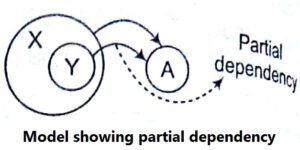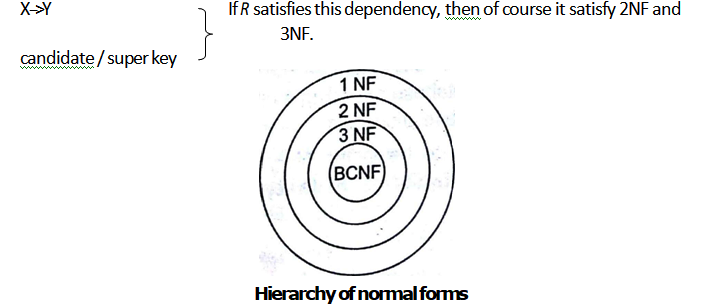Normalization in Database Tutorial Study Material Notes With Examples
Normal forms/Normalization
In relation database design, the normalization is the process for organizing data to minimize redundancy. Normalization usually involves dividing a data base into two or more tables and defining relationship between the tables.The normal forms define the status of the relation about the individuated attributes. There are five of normal forms.
First Normal Form (INF)
Relation should not contain any contain any multi-valued attributes or relation should contain atomic attributes.

The above relation is in 1 NF but now Stud_Id is no more a primary key. Now in the above case, we need to modify our primary key which is (Stud_Id, Course-Name)
Note: The main disadvantage of 1NF is high redundancy.
Second Normal Form (2NF)
Relation R is in 2NF if and only if
- R should be in 1NF.
- R should not contain any partial dependency.
Partial Dependency
Let R be the relational schema having X, Y, A, which are non- empty set of attributes ,where
X= Any candidate key of the relation .
Y= Proper subset of any candidate key
A = Non- prime attribute (i.e., A doesn’t belong to any candidate key)
In the above example, X A already exists and if Y -> A will exist then it will become a partial dependency, if and only if
- Y is a proper subset of candidate key.
- A should be non-prime attribute.
If any of the above two conditions fail, then Y -> A will also become fully functional dependency
Full Functional Dependency
A functional dependency P is said to be fully functional dependency, if removal of any attribute S from P means that the dependency doesn’t hold any more.
(Student_Name, College_Name –> College_Address)
Suppose, the above functional dependency is • a full functional
dependency, then we must ensure that there are no FDs as below.
(Student_Name —> College_Address)
or (College_Name -> Collage_Address)
Third Normal Form (3NF)
R be a relational schema, then any non-trivial FD X –>Y over R is in 3NF, if
- X should be a candidate key or super key.
or
- Y should be a prime attribute.
- Either both of the above conditions should be true or one of them should be true.
- R should not contain any transitive dependency.
- For a relation schema R to be a 3NF, it is necessary to be in 2NF.
Transitive Dependency
A FD, P –> Q in a relation schema R is a transitive if
- There is a set of attributes Z that is not a subset of any key of R.
- Both X –> Z and Z –>Y hold

- The above relation is in 2NF.
- In relation R, C is not a candidate key and D is non-prime attribute. Due to this, R1 fails to satisfy 3NF condition. Transitive dependency is present here.
AB —-> C and C D, then AB —-> D will be transitive.
Boycee Codd Normal Form (BCNF)
Boycee Codd Normal Form (BCNF) Let R be the relation schema and X –>Y be the any non-trival FD over R is in BCNF if and only if X is the candidate key or super key.


Fourth Normal Form (4NF)
4NF is mainly concerned with multi-valued dependency. A relation is in 4NF if and only if for every one of its non-trivial multivalued dependencies X –>H Y, X is a super key (i.e., X is either a candidate key or a superset).
Fifth Normal Form (5NF)
It is also known as Project Join Normal From (PJ/NF). 5NF reduces redundancy in relational database recording multivalued facts by isolating semantically related multiple relationships.
A table or relation is said to be in the 5NF, if and only if every join dependency in it, is implied by the candidate keys.
Key Points
- The Normal Forms (NF) of relational database theory provide criteria forr
- determining a table’s degree of vulnerability to logical inconsistencies an anomalies
- Databases intended for Online Transaction Processing (OLTP) are typically more normalized than databases intended for Online Analytical Processing (OLAP).
- OLTP applications are characterized by a high volume of small transactions such as updating a sales record at a supermarket checkout counter.
- The expectation is that each transaction will leave the database in a consistent state.
Sorting in Design and Analysis of Algorithm Study Notes with Example
Learn Sorting in Handbook Series: Click here
Follow Us on Social Platforms to get Updated : twiter, facebook, Google Plus
